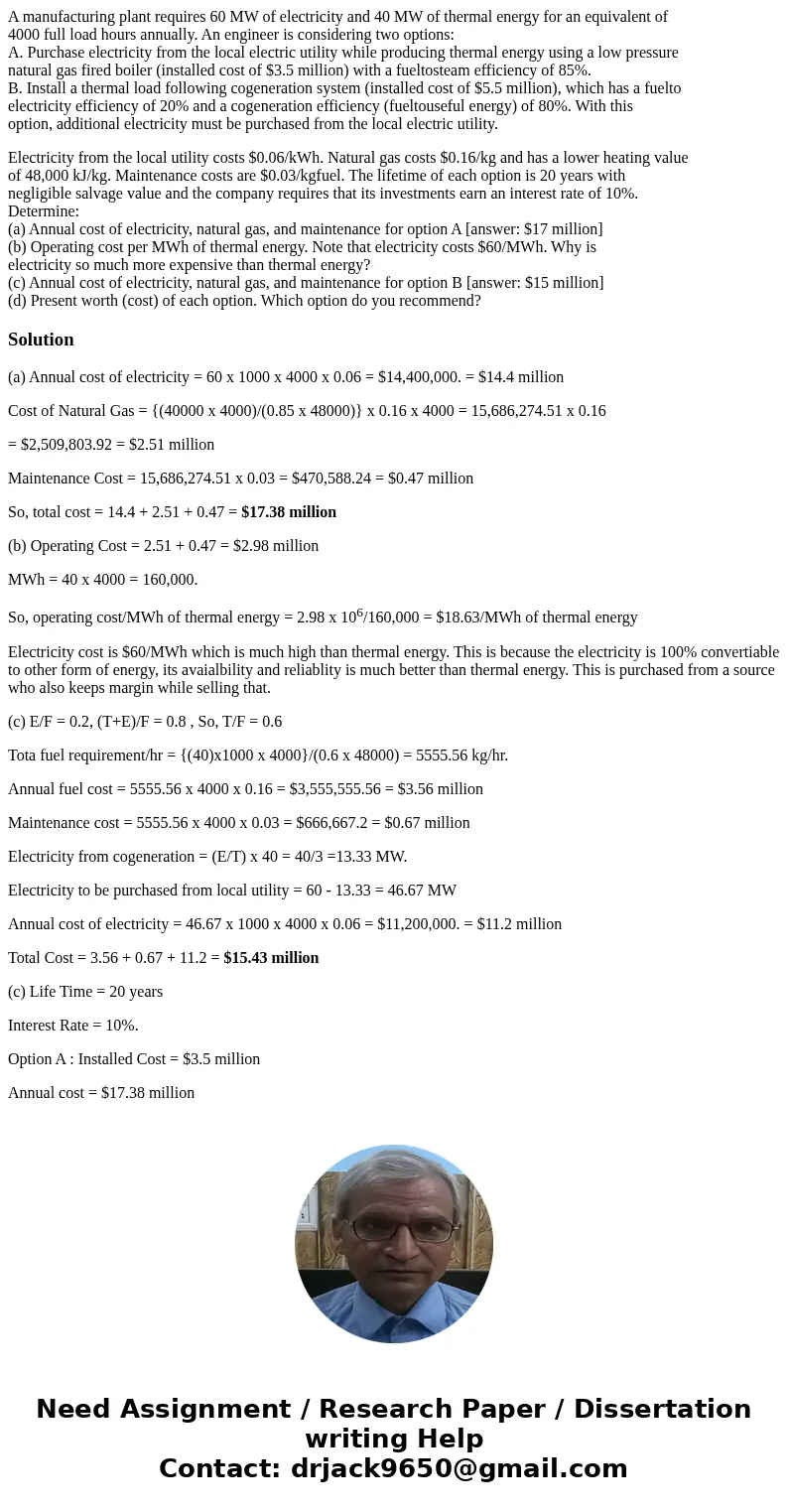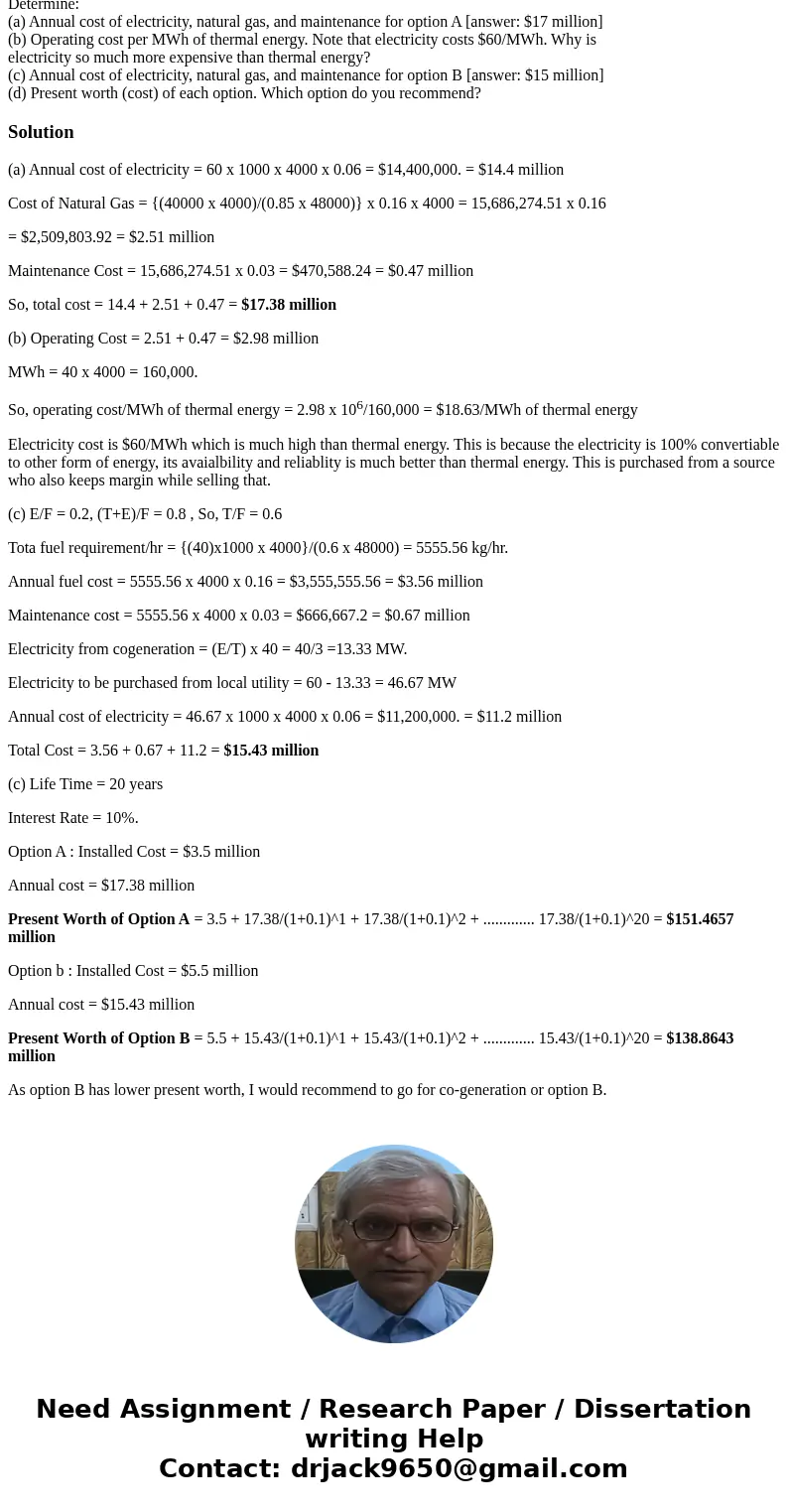A manufacturing plant requires 60 MW of electricity and 40 M
A manufacturing plant requires 60 MW of electricity and 40 MW of thermal energy for an equivalent of
4000 full load hours annually. An engineer is considering two options:
A. Purchase electricity from the local electric utility while producing thermal energy using a low pressure
natural gas fired boiler (installed cost of $3.5 million) with a fueltosteam efficiency of 85%.
B. Install a thermal load following cogeneration system (installed cost of $5.5 million), which has a fuelto
electricity efficiency of 20% and a cogeneration efficiency (fueltouseful energy) of 80%. With this
option, additional electricity must be purchased from the local electric utility.
Electricity from the local utility costs $0.06/kWh. Natural gas costs $0.16/kg and has a lower heating value
of 48,000 kJ/kg. Maintenance costs are $0.03/kgfuel. The lifetime of each option is 20 years with
negligible salvage value and the company requires that its investments earn an interest rate of 10%.
Determine:
(a) Annual cost of electricity, natural gas, and maintenance for option A [answer: $17 million]
(b) Operating cost per MWh of thermal energy. Note that electricity costs $60/MWh. Why is
electricity so much more expensive than thermal energy?
(c) Annual cost of electricity, natural gas, and maintenance for option B [answer: $15 million]
(d) Present worth (cost) of each option. Which option do you recommend?
Solution
(a) Annual cost of electricity = 60 x 1000 x 4000 x 0.06 = $14,400,000. = $14.4 million
Cost of Natural Gas = {(40000 x 4000)/(0.85 x 48000)} x 0.16 x 4000 = 15,686,274.51 x 0.16
= $2,509,803.92 = $2.51 million
Maintenance Cost = 15,686,274.51 x 0.03 = $470,588.24 = $0.47 million
So, total cost = 14.4 + 2.51 + 0.47 = $17.38 million
(b) Operating Cost = 2.51 + 0.47 = $2.98 million
MWh = 40 x 4000 = 160,000.
So, operating cost/MWh of thermal energy = 2.98 x 106/160,000 = $18.63/MWh of thermal energy
Electricity cost is $60/MWh which is much high than thermal energy. This is because the electricity is 100% convertiable to other form of energy, its avaialbility and reliablity is much better than thermal energy. This is purchased from a source who also keeps margin while selling that.
(c) E/F = 0.2, (T+E)/F = 0.8 , So, T/F = 0.6
Tota fuel requirement/hr = {(40)x1000 x 4000}/(0.6 x 48000) = 5555.56 kg/hr.
Annual fuel cost = 5555.56 x 4000 x 0.16 = $3,555,555.56 = $3.56 million
Maintenance cost = 5555.56 x 4000 x 0.03 = $666,667.2 = $0.67 million
Electricity from cogeneration = (E/T) x 40 = 40/3 =13.33 MW.
Electricity to be purchased from local utility = 60 - 13.33 = 46.67 MW
Annual cost of electricity = 46.67 x 1000 x 4000 x 0.06 = $11,200,000. = $11.2 million
Total Cost = 3.56 + 0.67 + 11.2 = $15.43 million
(c) Life Time = 20 years
Interest Rate = 10%.
Option A : Installed Cost = $3.5 million
Annual cost = $17.38 million
Present Worth of Option A = 3.5 + 17.38/(1+0.1)^1 + 17.38/(1+0.1)^2 + ............. 17.38/(1+0.1)^20 = $151.4657 million
Option b : Installed Cost = $5.5 million
Annual cost = $15.43 million
Present Worth of Option B = 5.5 + 15.43/(1+0.1)^1 + 15.43/(1+0.1)^2 + ............. 15.43/(1+0.1)^20 = $138.8643 million
As option B has lower present worth, I would recommend to go for co-generation or option B.


 Homework Sourse
Homework Sourse